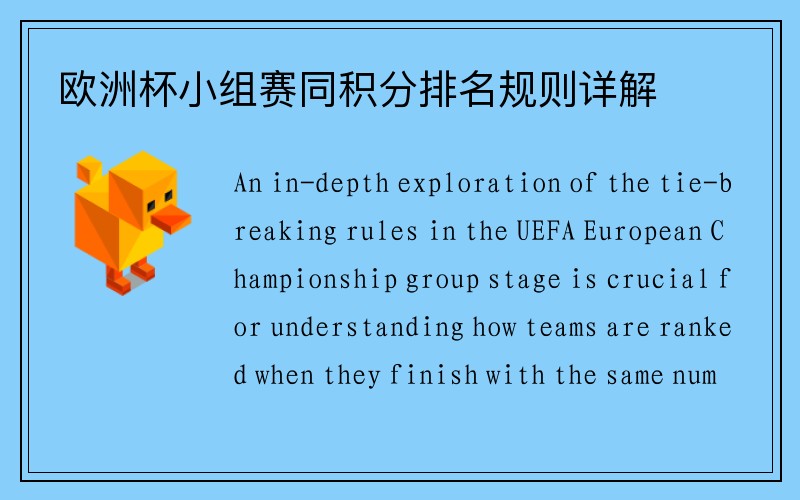欧洲杯小组赛同积分排名规则详解
An in-depth exploration of the tie-breaking rules in the UEFA European Championship group stage is crucial for understanding how teams are ranked when they finish with the same number of points. This article delves into four key aspects: goal difference, goals scored, head-to-head results, and fair play conduct, providing clarity on the intricate regulations that shape tournament outcomes.

1、Goal Difference
Goal difference serves as the primary tiebreaker in UEFA Euro group stages, determining the ranking of teams with equal points. It is calculated by subtracting the total goals conceded from the total goals scored over all group matches. This criterion aims to reward teams with a stronger offensive and defensive balance, highlighting consistency and proficiency throughout the tournament.
Teams strive to maximize their goal difference by scoring more goals than they concede, thereby enhancing their chances of advancing in case of tied points with other teams in their group. The emphasis on goal difference underscores the importance of both attacking prowess and defensive solidity in competitive football.
In situations where two or more teams have the same points and identical goal differences, the criterion shifts to goals scored, emphasizing the frequency and effectiveness of a team's scoring capabilities throughout the group stage.
2、Goals Scored
Following goal difference, the total number of goals scored by a team across all group matches becomes the next determinant in breaking ties. This criterion directly reflects a team's offensive productivity and ability to consistently find the back of the net against varying opposition.
Teams with a higher tally of goals scored gain an advantage in tie-breaking scenarios, showcasing their offensive prowess and potentially securing a higher rank in the group standings. Goals scored also serve as a critical indicator of a team's attacking strategy and effectiveness in capitalizing on scoring opportunities throughout the tournament.
By prioritizing goals scored after goal difference, UEFA ensures a fair evaluation of teams' offensive contributions, thereby promoting an engaging and competitive atmosphere in group stage matches.
3、Head-to-Head Results
When two or more teams are still tied after considering both goal difference and goals scored, the next criterion is the results of matches played directly between the tied teams. This head-to-head record serves as a decisive factor in determining the higher ranked team within the group.
The head-to-head rule emphasizes the outcomes of specific matchups between tied teams, providing a direct comparison of their performance against each other. A team with superior results in head-to-head encounters gains precedence, highlighting their ability to perform under pressure and secure favorable outcomes when directly competing against their group rivals.
This criterion enhances the competitive nature of the UEFA Euro group stage, encouraging teams to excel in their direct confrontations and potentially influence their final standings in the tournament.
4、Fair Play Conduct
As a final tiebreaker if teams remain equal after considering goal difference, goals scored, and head-to-head results, UEFA Euro employs fair play conduct to determine the higher ranked team. Fair play conduct is assessed based on the number of yellow and red cards received throughout the tournament.
Teams with fewer disciplinary infractions, as indicated by a lower cumulative total of yellow and red cards, receive preference in the standings. This criterion promotes sportsmanship and discipline on the field, emphasizing respectful conduct and adherence to the rules of the game.
The fair play rule serves as a unique tiebreaker, offering teams an opportunity to influence their final ranking through exemplary behavior and responsible play throughout the tournament.
总结:
利来w66Understanding the tie-breaking rules in UEFA Euro group stages is essential for teams aiming to advance in the tournament. Goal difference and goals scored serve as primary criteria, highlighting teams' offensive and defensive capabilities. Head-to-head results provide a direct comparison between tied teams, while fair play conduct emphasizes sportsmanship and discipline. Together, these rules ensure a fair and competitive environment, determining the final standings of teams with equal points.
The tie-breaking mechanisms not only shape tournament outcomes but also underscore the strategic importance of each match in influencing a team's advancement in the UEFA European Championship.